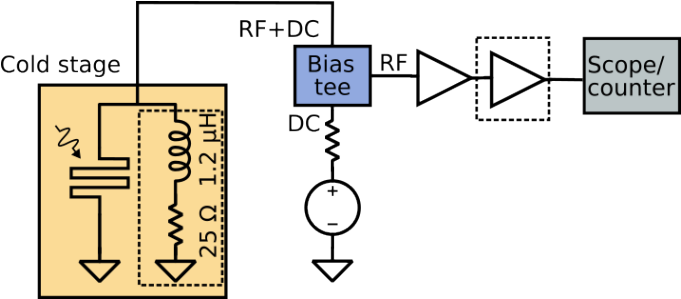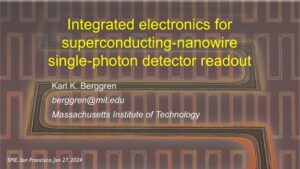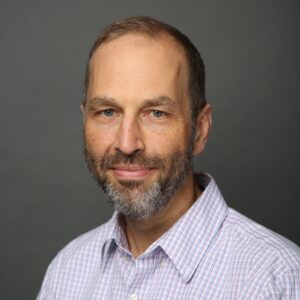News
New Publication: Effects of Helium Ion Exposure on the Single-Photon Sensitivity of MgB₂ and NbN Detectors

New publication: Emma Batson, Francesca Incalza, Matteo Castellani, Marco Colangelo, Ilya Charaev, Andreas Schilling, Sergey Cherednichenko, and Karl K. Berggren. “Effects of Helium Ion Exposure on the Single-Photon Sensitivity of MgB₂ and NbN Detectors,” IEEE Transactions on Applied Superconductivity, (2024).
Caption: The readout electronics setups for magnesium diboride wires and niobium nitride wires were nearly identical, with optional components shown in dashed lines. A cold-stage off-chip shunt was necessary to prevent latching in the wide magnesium diboride wires. Bias current was provided by a voltage source and a 1 kΩ resistor for the wide magnesium diboride wires or a 10 kΩ resistor for the narrow NbN wires. At low temperatures in the wide wires, only one stage of amplification was necessary. Detectors were illuminated with a 1550 nm laser (magnesium diboride) or 780 nm laser (niobium nitride) through a fiber-optic cable.
Abstract
Improving the scalability, reproducibility, and operating temperature of superconducting nanowire single photon detectors (SNSPDs) has been a major research goal since the devices were first proposed. The recent innovation of helium-ion irradiation as a post-processing technique for SNSPDs could enable high detection efficiencies to be more easily reproducible, but is still poorly understood. Additionally, fabricating detectors at micron-wide scales from high-T_C materials could improve scalability and operating temperature, respectively. At the same time, fabrication of successful devices in wide wires and from higher-T_C materials like magnesium diboride has proven challenging. In this work, we compare helium ion irradiation in niobium nitride and magnesium diboride detectors with different material stacks in order to better understand the mechanics of irradiation and practical implications of encapsulating layers on effective dose. We examine the effects of experimental effective dose tests and compare these results to the damage per ion predicted by simulations in corresponding material stacks. In both materials, irradiation results in an increase in count rate, though for niobium nitride this increase has not fully saturated even at the highest tested dose of 2.6×1017 ions/cm^2 , while for resist-encapsulated magnesium diboride even the lowest tested dose of 1×1015 ions/cm^2 appears higher than optimal. Our results demonstrate the general applicability of helium ion irradiation to vastly different devices and material stacks, albeit with differing optimal doses, and show the reproducibility and effectiveness of this post-processing technique in significantly improving SNSPD efficiency.
The pdf can be accessed here, under the following copyright understanding: “© 20XX IEEE. Personal use of this material is permitted. Permission from IEEE must be obtained for all other uses, in any current or future media, including reprinting/republishing this material for advertising or promotional purposes, creating new collective works, for resale or redistribution to servers or lists, or reuse of any copyrighted component of this work in other works.”
New Publication: Single-photon detection using large-scale high-temperature MgB2 sensors at 20 K

Full article citation: I. Charaev et al., “Single-photon detection using large-scale high-temperature MgB2 sensors at 20 K,” Nat Commun, vol. 15, no. 1, p. 3973, May 2024.
The article is Open Access and can be viewed here.
Abstract
Prof. Berggren SPIE Presentation Available

Prof. Karl Berggren gave a presentation on Integerated Electronics for Superconducting-nanowire Single-photon Detector Readouts at the SPIE Quantum West conference this January. The recording of this presentation is now available in the SPIE Digital Library. To access the talk, you may need to be on a University or library network.
Abstract
Superconducting single-photon detectors are a key technology for quantum information science, being of particular use for quantum key distribution and photonics-based quantum computing. However, the biasing, readout, and signal processing associated with the detector is typically handled by off-chip conventional semiconductor electronics. Increasingly, this solution is proving problematic: such electronics consume large amounts of power and are cumbersome to integrate on the same chip as the detectors. Superconducting classical electronics relying on Josephson junctions are an alternative, but require an integrated fabrication process, which adds complexity to the device. An alternative is to use the superconducting nanowires themselves, in the form of “cryotrons”, an alternative to Josephson junction superconducting switches first proposed in the 1950s, but recently experiencing renewed interest with scaling to the nanometer length scale. These technologies and applications of them to SNSPD readout and signal processing will be discussed.
The full talk can be found in the SPIE Digital Library here.
Professor Berggren named a 2024 MacVicar Faculty Fellows

Congratulations to Karl for being awarded the MIT MacVicar award for undergraduate teaching!
The full details are available at the MIT News website.
QNN Newsletter – 2023 Wrap Up
QNN Newsletter
Dear QNN Group Members, Alums and Affiliates,
We are excited to share our group newsletter for the last quarter of 2023 with you all. Please read on for highlights of the latest research and goings on within the QNN group.
The last term saw a lot of change. We have welcomed four new group members, and saw the departure of three others. Also, the wider QNN community has grown by two with Marco Colangelo and Stewart Koppell both becoming new fathers. Marco welcomed baby Lorenzo, and Stewart baby Cleo. We are wishing the new parents well!
Best regards,
Karl and Donnie
Comings and Goings
This past semester, we’ve welcomed the following new group members:
- Felix Ritzkowksi, Postdoc
- Valentin Karam, no longer an exchange student, officially a Research Support Associate
- Simon Opsahl, UROP
- Steven Khandeh, UROP
The following members have now left and become alumni group members:
- Marco Zagarella, visiting student returning to Italy
- Stewart Koppell, Post-doc, now at Johns Hopkins in Austin, Texas
- Ashley Lou, UROP
Thesis Presentation
Francesca Incalza, “Effects of helium-ion exposure on superconducting nanowires single photon detectors,” Virtual, Jun. 30, 2023. Presentation Link.
Publications (6/1/23 – 12/31/23)
[1]
L. C. Blackburn, E. Golden, A. Wynn, A. Wagner, and N. Gershenfeld, “Design and Simulation of Phase Synchronizer for Adiabatic Quantum Flux Parametron Circuits,” IEEE Transactions on Applied Superconductivity, vol. 33, no. 5, pp. 1–5, Aug. 2023, doi: 10.1109/TASC.2023.3243186.
[2]
J. S. Luskin et al., “Large active-area superconducting microwire detector array with single-photon sensitivity in the near-infrared,” Applied Physics Letters, vol. 122, no. 24, p. 243506, Jun. 2023, doi: 10.1063/5.0150282.
[3]
J. W. Simonaitis and P. D. Keathley, “Twin experiments reveal twin electron dynamics,” Nat. Phys., pp. 1–2, Jun. 2023, doi: 10.1038/s41567-023-02066-8.
Preprints (6/1/23 – 12/31/23)
[1]
I. Charaev et al., “Single-photon detection using large-scale high-temperature MgB$_2$ sensors at 20 K.” arXiv, Aug. 29, 2023. Accessed: Nov. 06, 2023. [Online]. Available: https://arxiv.org/abs/2308.15228
[2]
A. Chou et al., “Quantum Sensors for High Energy Physics.” arXiv, Nov. 03, 2023. Accessed: Nov. 13, 2023. [Online]. Available: http://arxiv.org/abs/2311.01930
[3]
C. Kim et al., “Wafer-Scale MgB2 Superconducting Devices.” arXiv, Dec. 2023. doi: 10.48550/ARXIV.2305.15190.
[4]
S. Lee et al., “First Detection of 120 GeV Protons with Superconducting Nanowire Detectors.” arXiv, Dec. 20, 2023. Accessed: Jan. 26, 2024. [Online]. Available: http://arxiv.org/abs/2312.13405
[5]
F. Ritzkowsky et al., “Large Area Optical Frequency Detectors for Single-Shot Phase Readout.” arXiv, Jun. 02, 2023. doi: 10.48550/arXiv.2306.01621.
[6]
H. K. Warner et al., “Coherent control of a superconducting qubit using light.” arXiv, Oct. 24, 2023. doi: 10.48550/arXiv.2310.16155.
[7]
M. Yeung, L.-T. Chou, M. Turchetti, S.-H. Chia, K. K. Berggren, and P. D. Keathley, “Lightwave Electronic Harmonic Frequency Mixing.” arXiv, Jul. 27, 2023. doi: 10.48550/arXiv.2307.15145.
Talks (6/1/23 – 12/31/23)
EIPBN 2023
J. Simonaitis, “A Low-Energy Counting Electron Spectrometer Integrated into a Scanning Electron Microscope,” presented at the EIPBN 2023, San Francisco, CA, Jun. 01, 2023.
J. Simonaitis, “Apparatus for studying low energy electron-photon interactions inside a Scanning Electron Microscope,” presented at the EIPBN 2023, San Francisco, CA, Jun. 01, 2023.
IVNC2023
A. R. Bechhofer, S. Nirantar, L. Daniel, K. K. Berggren, and P. D. Keathley, “Circuit Model for Nanoscale Optical Frequency Electronics,” presented at the IVNC2023, Cambridge, MA, Jul. 10, 2023.
J. Simonaitis, “Electron-Photon Interaction is a Scanning Electron Microscope,” presented at the IVNC 2023, Cambridge, MA, Jul. 11, 2023.
EUCAS 2023
Emma Batson, “Electrical Characterization of Micron-Wide Magnesium Diboride Wires for SuSPDs,” presented at the EUCAS 2023, Bologna, Italy, Sep. 04, 2023.
Emma Batson, “Superconducting nanowire devices in novel materials: High critical temperatures and transparent superconductors,” presented at the HTSHFF 2023, Giardini Naxos, Italy, Sep. 13, 2023.
PCTS
K. K. Berggren, “Superconducting-Nanowires for High-Energy Physics and Fundamental Science Applications,” presented at the PCTS: Quantum Probes of Wave-like and Sub-GeV Dark Matter, from Photonics to Quantum Sensing, Princeton, NJ, Oct. 27, 2023.
Prof. Berggren South Korea Engagements
K. K. Berggren, “Superconducting Nanostrip Detectors: From Quantum Communications to Dark-Matter Search,” presented at the LTD20, Daejeon, South Korea, Jul. 25, 2023.
K. K. Berggren, “Why Should Everyone Care About Superconducting Nanowire Single-Photon Detectors?,” Korea Institute of Industrial Technology (KITECH), Ulsan, South Korea, Jul. 28, 2023.
K. K. Berggren, “Detecting Dark Matter with Superconducting Nanowires,” Institute for Basic Sciences, Daejeon, South Korea, Jul. 31, 2023.
K. K. Berggren, “Superconducting Nanostrip Single-Photon Detectors for Quantum-Information,” KAIST, Daejeon, South Korea, Jul. 31, 2023.
To unsubscribe or subscribe email wijtmans@mit.edu.